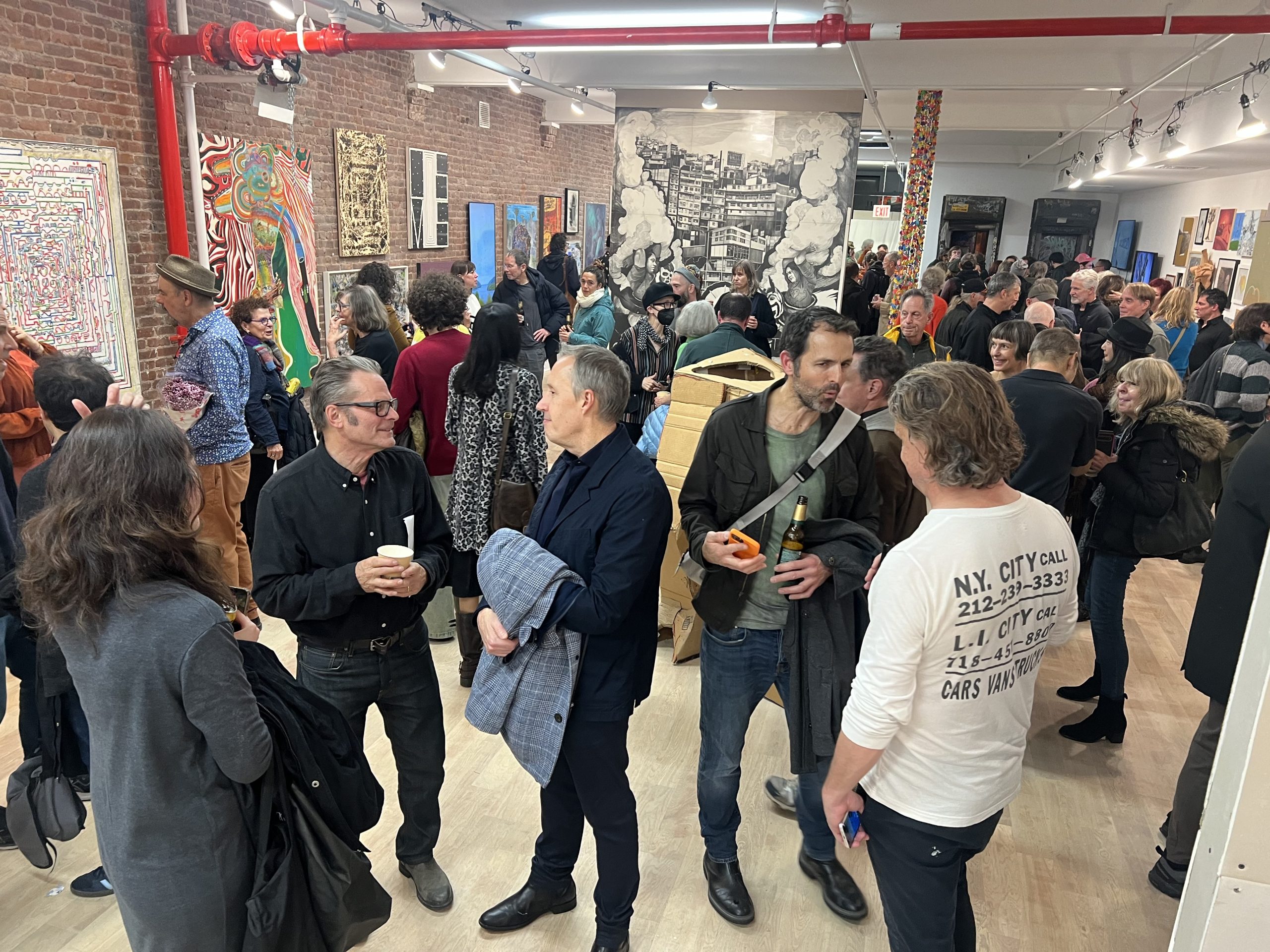When Williamsburg’s Pierogi Gallery asked Andrew Ohanesian to contribute to a group show commemorating the art space’s 30th anniversary this month, he had an inkling that his “kegerator” was coming out of storage.
The Brooklyn-based installation artist has frequently worked on a large scale, constructing a life-size airport jetway and a one-story house inside the confines of Pierogi’s satellite space The Boiler that visitors were allowed to destroy in any way they liked.
But Ohanesian was only given a closet-sized corner of the room. So he refabricated the kegerator, a piece he originally made in 2010 consisting of a wooden bar on top of a hidden keg surrounded by four weathered wood walls and an old-fashioned light fixture. Ohanesian named it “Mandies,” which reflected his bleak mindset at the time (“man dies”).
“I was doing nothing productive for my career in New York and felt like I was drinking myself to death in a tiny coffin-size bar, and then thought, ‘build that,’” he said. “It was supposed to be a piece about death, and it is, but everyone cheerily ignores that.”

Life has gotten better for Ohanesian since then. He toasted scores of art world luminaries last week at the opening of Pierogi’s exhibition, which was so exhaustive it had to be held offsite, in a Tribeca warehouse at 394 Broadway. More than 80 artists contributed 163 works, representing the unassuming gallery’s three-decade history, including Fred Tomaselli, Hugo Crosthwaite, Tavares Strachan, Jonathan Schipper, Nicole Eisenman, Roxy Paine, David Kramer, David Scher, and Rico Gatson.
For one night, it felt like a family reunion for the Williamsburg art scene.
“It was really remarkable to see everyone,” Joe Amrhein, Pierogi co-owner, said. “There were a lot of artists we don’t show anymore, and some artists who have passed away. I’d like to dedicate the show to the people who have passed.”

The story of Pierogi began in the mid-1990s, when Amrhein and his partner, Pierogi co-owner Susan Swenson, collected work from their friends in flat files and began displaying them on the first floor of their North 9th Street loft building.
Willy Hartland, a Williamsburg filmmaker who curated an animation show with Pierogi in 2023, often attended the gallery’s openings on Friday nights after work at his job as an animator for the TV show Beavis and Butt-Head (1993–2011), because he lived a block away.
“It was a great meeting place and you would run into your friends there,” he said. “It was a social thing. I never thought in a million years I would have a show there.”
By 1992, Williamsburg had been anointed the “new bohemia” due to its dense concentration of artists, many of whom moved across the river from the East Village due to the lower prices (an art studio went for $250 a month back then). The neighborhood’s vibrant art scene consisted of a mix of commercial galleries such as Front Room and Annie Herron’s Test-Site; artist-run exhibition spaces including Michael Ballou and Adam Simon’s Four Walls, Momenta Art, and Galapagos Art Space; and periodic all-night art raves called Cat’s Head and Fly Trap in vacant factories along the Williamsburg waterfront.

But Pierogi was arguably one of the most ambitious. Several shows garnered critical acclaim, especially the gallery’s reconstitution of Robert Smithson’s “Dead Tree” (1969) in May 1997. In 1998, they began participating in art fairs, including the Armory Show, at which they have remained a steady presence.
“Part of the reason they’ve been able to stay in Williamsburg is because they’ve been doing a lot of art fairs,” said Lisa Levy, a Bushwick-based performance artist who conducted impromptu artist interviews at the opening. “Their gallery was getting brand exposure even though they’re not in Manhattan.”
Soon, that will change. Pierogi is looking to move to Tribeca next year, although Amrhein and Swenson plan on keeping their original location for their office and storage needs. They had previously opened an exhibition space on Suffolk Street in the Lower East Side in 2016, but shuttered it during the pandemic. When they explored locations in Chelsea, they found the neighborhood “too corporate.”

Instead, Tribeca’s burgeoning arts community and proximity to collectors has become a strong draw for many galleries that started in other parts of the city. The 4,000-square-foot space that they are currently renting for their group show, which is across from Marian Goodman Gallery’s new flagship, is an option, if they can find another organization to subdivide it with them.
“We’re trying to figure out what brick-and-mortar means these days, since Instagram and the Internet-viewing of art has changed,” he said. “We opened in a community and flourished in that concept of an artist community. That community exists in Tribeca now. Williamsburg is not a destination now.”
If their anniversary show was any indication, Pierogi will be able to transport its community wherever they go. For that, artists like Ohanesian are grateful.
“Pierogi has been so incredibly supportive of this work,” he said. “It’s difficult work to do the build-outs and go to the extreme of killing myself for three weeks to prank the art world. It’s my favorite installation of the bar and it’s meant to be in the gallery.”


